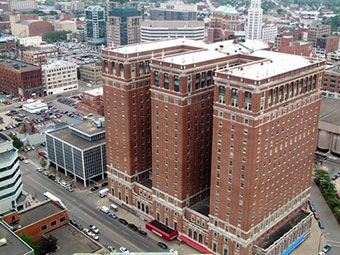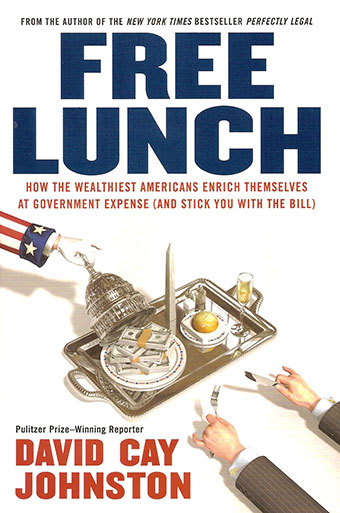Next story: Learning to Love Big Brother
Culture of Subsidy
by Bruce Fisher

The waste goes on: the misdirection of scarce public resources
While Erie Canal Harbor Development Corporation is currently spending more than $6 million on contracts with various architectural, engineering, marketing, and planning consultants for a big-box retail project that has no public support, the iconic Statler Hilton Hotel at the center of downtown Buffalo could decline irretrievably unless about $5 million is invested to stabilize it before the snow flies. Concurrently, about a mile south toward the Buffalo River, the empty 1960s General Donovan office building, across from what used to be War Memorial Auditorium but which is now a hole in the ground, is in limbo—a limbo from which it may escape if it becomes home to a law firm that today rents space less than 200 yards away in another potentially doomed building, the HSBC office tower.
The money that has to come to stabilize the Statler is going to have to be public money, because there’s a simple cost-benefit analysis that precedes the preservationists’ concerns about the integrity of Niagara Square: If taxpayers don’t come up with the $5 million that will make a rehab of the 800,000-square-foot building possible, then taxpayers will have to come up with at least $15 million to tear the landmark down. Ditto the publicly owned General Donovan office building across from the publicly owned Aud site. Taxpayers will pay to fix it, or taxpayers will pay to demolish it.
And while nobody much likes the Bass Pro plan any more, the Erie Canal Harbor Development Corporation is committed to spending $153 million in public funds—funds that will save neither the Statler nor the General Donovan building, but which will instead create a couple of thousand new parking spaces, some retail space in an area that supports only lunch counters and newsstands, and even more commercial and office space in a downtown that is more than 20 percent empty already.
The new federal courthouse on Niagara Square, one recalls, is on a piece of land that until just a couple of years ago had an award-winning adaptive-reuse structure, formerly the Erlanger Theater, housing a major law firm, a major investment firm, a union office, and a Greek restaurant.
Welcome to downtown Buffalo, New York, where for the past 40 years, massive public investments for big projects have, year after year, project after project, proceeded as follows: A useful historic building is left to rot, then demolished at great public expense, then replaced, if at all, by a hugely expensive, publicly funded structure that worsens the already enormous glut of downtown office space. It’s a process that relies on what a former New York Times reporter calls “the subsidy culture of Buffalo.”

The reporter is David Cay Johnston, who won the Pulitzer Prize before he wrote his book, Free Lunch: How the Wealthiest Americans Enrich Themselves at Government Expense (and Stick You With the Bill). Johnston refers frequently to Buffalo in this book, mainly because of the $100 million in tax breaks, subsidies, cheap or free electricity, and other goodies handed out to Buffalo News owner Warren Buffett that led his insurance firm Geico to locate in Amherst.
The subsidy culture is alive and well here in Upstate New York. It’s not just Buffett and Geico. It’s Yahoo, the search engine company that just obtained a huge public subsidy to locate a server farm in Lockport. It’s a Rochester hotel, which was just built with no so-called earnest money from the owners of the hotel, but rather, solely with public subsidy. It’s the forthcoming Verizon complex, destined for a rural area in Niagara County near the coal-fired power plant in Somerset. And it’s another handful of projects just funded by the Erie County Industrial Development Agency, several of which are medical offices, i.e., offices of people who already do business here, whose client base is here and only here, but who nevertheless stand to get public money to support their businesses because “economic development” in Upstate New York means subsidizing real-estate developers to produce ever-more space.
The handouts make it all possible. We are accustomed to this in Upstate; what’s alarming about Johnston’s Free Lunch is how widespread the handouts are, all across America. A visit to Buffalo is like reading through Johnston’s account of Enron, Geico, various banks and health-insurance companies, a golf-course project in Oregon, the sporting-goods behemoths Cabela’s and Bass Pro, and more, depressingly more. Everywhere you look in America, somebody who is very rich is ripping off the public and getting away with it. Everywhere in America, some journalist or whistle-blower is getting marginalized, fired, sued, or intimidated for pointing out the outrage.
Since there is evidently no prospect of this enervating, thoroughly corrupt system ending, the question the rest of us have to ask is this: Is there any public benefit or justification for any of this stuff?
Perhaps. A 2004 study commissioned by the City of Buffalo suggested that there may possibly be a market for as many as 375 new units of housing in downtown, by which they mean the Central Business District northwards to about Allentown. The Brookings Institution’s Metropolitan Policy project applauds downtown housing; metro maestro Bruce Katz has gone from Rust Belt town to Rust Belt town, from Columbus to Pittsburgh to Cleveland and beyond, urging those burgs to attract, incentivize, or otherwise get themselves 2,000 to 3,000 new downtown residents pronto, on the theory that reaching a new threshold of density through downtown housing might just turn the tide for shrinking Rust Belt cities.
The theory seems to be working in handout-happy Buffalo. Statistics from a recent Buffalo Place survey indicate that there is a small but steady market for downtown living already: Every one of the approximately 1,000 units of new residential living space—it’s mainly rental space, but okay—has been leased or sold since they came online after 2000.
So if the Statler becomes, as preservationists suggest, a stabilized structure with some new office tenants, some new (or old) saloon and eatery, and service tenants, then the Statler could possibly be a place that could possibly develop, inch by inch, year by year, floor by floor, as a cluster of new home addresses. Two hundred 2,000-square-foot residences in the Statler would soak up half the available space and still leave enough for the Golden Ballroom and a shoeshine stand and a place for the Federal District Court judges, whose glorious new home will open next year on Niagara Square, to buy the Racing Form.
So besides serving as a platform for peregrine falcon nests, the Statler could, were it still standing, conceivably find a new use. That’s because there is an actual market demand for downtown housing, and, as Carl Paladino has shown with his University Club apartments and other adaptive re-uses, there’s money in it.
Mixed-use development for a market mini-surge of hipsters, first-time homebuyers, empty-nesters, and possibly also some college students—here are a couple of hundred Buffalo State College students currently using the Adams Mark Hotel as a dorm—would seem to be a reasonable rationale for the taxpayer to step in and prevent the creation of a “shovel-ready” crater on the current site of the Statler Hotel. Next Monday, in bankruptcy court, there may be some decisions made.
But there have already been decisions made by the Erie Canal Harbor Development Corporation, which controls more than $150 million of public funds—decisions to hire $6 million worth of mainly out-of-town consultants, decisions to spend millions more on making fake “canals” next to the genuine terminus of the Erie Canal, and decisions to construct more parking in a part of downtown that already is glutted with parking. (The HSBC Atrium parking lot is never filled to capacity, not even at peak usage time.) There is no coordination of all this public money. There is no prioritization—did Buffalo truly need a new $60 million federal courthouse while its river, canal, and lake water all violate the Clean Water Act and international law too? Why did Buffalo stand by idly while the previous several owners of the Statler let it rot, and why today does city government stand idly by while 11th-hour efforts to save it need city help? Why does the region need New York State authorities to use public money to subsidize new office space and parking when there’s an alarming shortage of public money and an alarming over-supply of office space and parking?
There are answers to these questions. They can be had in the pages of Johnston’s Free Lunch. Or they can be had in the sweet, cool autumn air of Buffalo, New York, where 40 percent of the metro area’s households have incomes under $20,000 a year, and where there is approximately four times as much retail space per capita as in Portland, Oregon, and where there are between four and six new houses built for each household formed. Subsidies for development aren’t making people richer. Subsidies for retail development won’t create more customers. And building more houses won’t create more people in a region that is becoming smaller. Saving an iconic building for some future use makes sense, if only because it’s less expensive than tearing it down.
But meanwhile, if somebody wants to change the business climate in this state, there’s only one thing to do: End the handouts.
Bruce Fisher is visiting professor of economics and finance at Buffalo State College, where he directs the Center for Economic and Policy Studies.
blog comments powered by Disqus|
Issue Navigation> Issue Index > v9n45 (week of Thursday, November 11) > Culture of Subsidy This Week's Issue • Artvoice Daily • Artvoice TV • Events Calendar • Classifieds |









 Current Issue
Current Issue